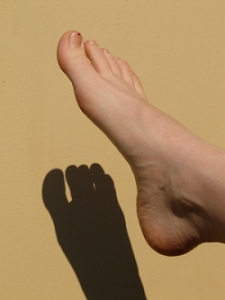
Foot and ankle problems usually fall into the following categories:
• Acquired from improper footwear, physical stress, or small mechanical changes within the foot.
• Arthritic foot problems, which typically involve one or more joints.
• Congenital foot problems, which occur at birth and are generally inherited.
• Infectious foot problems, which are caused by bacterial, viral, or fungal problems.
• Neoplastic disorders, also known as tumors, which are the result of abnormal growth of tissue anywhere on the foot and may be benign or malignant.
• Traumatic foot problems, which are associated with foot and ankle injuries, such as fractures.
Leading foot problems are:
• Bunions—misaligned big toe joints that swell and become tender, causing the first joint of the big toe to slant outward and the second joint to angle toward the other toes. Bunions tend to be hereditary, but can be aggravated by shoes that are too narrow in the forefoot and toe. Conservative methods prior to any surgical intervention should be considered as the primary option.
• Hammertoes—usually stemming from muscle imbalance, this condition occurs when the toe is bent into a claw-like position. Hammertoe can affect any toe, but most frequently occurs to the second toe, when a bunion slants the big toe toward and under it. Selecting shoes and socks that do not cramp the toes may help alleviate any aggravation of pain or discomfort.
• Heel Spurs—growths of bone on the underside, forepart of the heel bone. Heel spurs occur when the plantar tendon pulls at its attachment to the heel bone. This area of the heel later calcifies to form a spur. Proper warm-up and the use of appropriate athletic shoes can reduce the strain to the ligament and prevent the formation of heel spurs.
• Ingrown Toenails—toenails with corners or sides that dig painfully into the skin. Ingrown toenails are usually caused by improper nail trimming, but can also result from shoe pressure, injury, fungus infection, heredity, and poor foot structure. Women are more likely to have ingrown toenails than men. The problem can be prevented by trimming toenails straight across, selecting proper shoe styles and sizes, and responding to foot pain in a timely manner.
• Neuromas—enlarged benign growths of nerves, most commonly between the third and fourth toes. Neuromas are caused by tissue rubbing against and irritating the nerves. Pressure from ill-fitting shoes or abnormal bone structure can also lead to this condition. Depending on the severity, treatments may include orthotics (shoe inserts), cortisone injections, FMT, Laser therapy, Alcohol sclerosing injections, etc.
• Plantar Fasciitis—an inflammation on the bottom of the foot that leads to heel and/or arch pain. A variety of foot injuries or improper foot mechanics can lead to plantar fasciitis. Treatments range from icing and foot exercises to the prescription of custom orthotics to correct the foot position and help alleviate pain. See our section on heel pain.
• Sesamoiditis—an inflammation or rupture of the two small bones (known as sesamoids) under the first metatarsal bone. Proper shoe selection and orthotics can help.
• Shin Splints—pain on either side of the leg bone caused by muscle or tendon inflammation. Shin splints are related to excessive foot pronation, but also may be related to a muscle imbalance between opposing muscle groups in the leg. Proper stretching before and after exercise and corrective orthotics for pronation can help prevent shin splints.
• Stress Fractures—incomplete cracks in bone caused by overuse. With complete rest, stress fractures in toes or any bones of the foot heal quickly. Extra padding in shoes can help prevent the condition. Left untreated, stress fractures may become complete bone fractures, which require casting and immobilization.